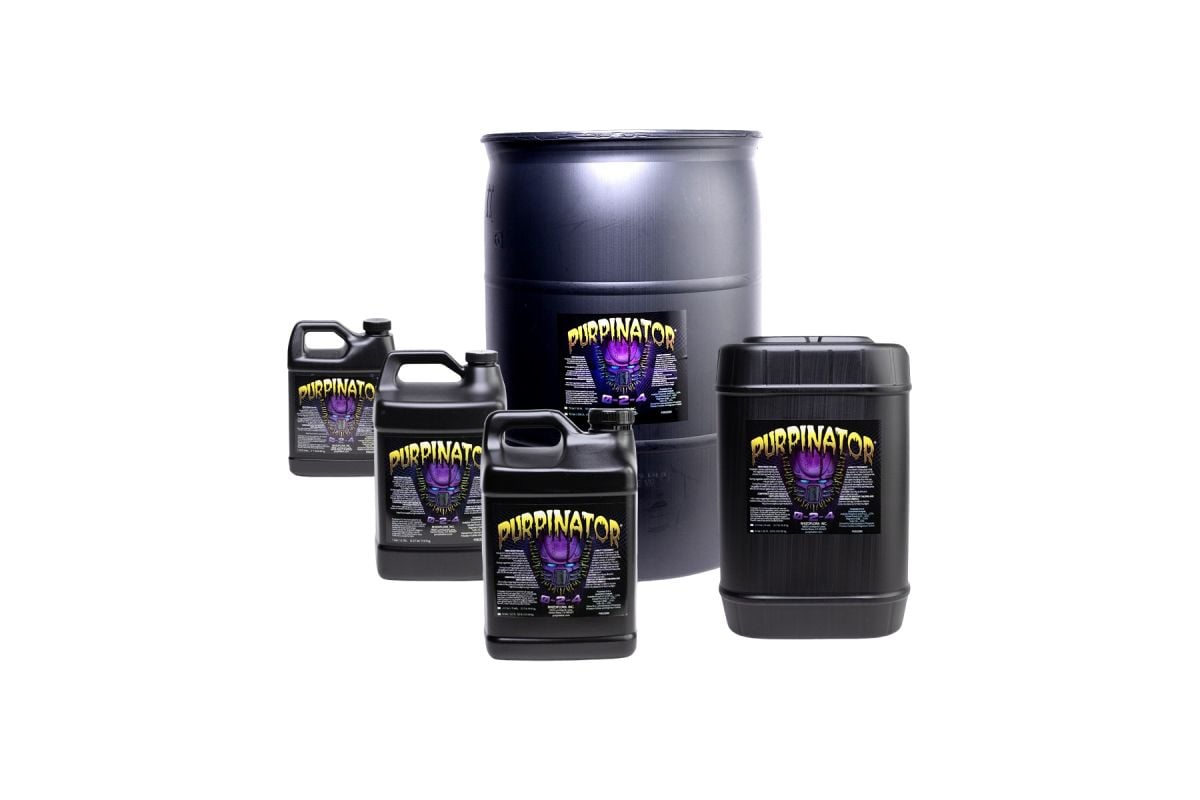RhizoFlora Purpinator
Purpinator is a specialty nutrient additive formulated to deliver increased flavonoid, terpenoid, and resin production in your plants. In addition to these benefits, Purpinator will improve the coloration of plants with purple phenotypes.
Much like its predecessor, Terpinator, Purpinator activates the metabolic pathways for trichome and terpene production in plants by providing the building blocks for these processes.
Purpinator will also regulate the pH of the cell sap in plant vacuoles, resulting in a more neutral cell sap pH which yields increased purple coloration expressed in the plant.
More about RhizoFlora Purpinator
Purpinator is a specialty nutrient additive created with cultivators in mind. The unique formulation includes a variety of inputs designed to provide users with increased production of flavonoids like anthocyanins, which improve coloration of the plant to deliver deep, rich hues of purple in capable cultivars. Purpinator’s all natural formulation enhances your plant’s “purple” color without inducing stress or modifying the growing environment, making it a unique and powerful tool for any cultivator who wants to get the most out of their plants. Alongside the benefits of enriched coloration provided by Purpinator comes an increase in the production of terpenes and secondary metabolites thanks to the incorporation of technology pioneered by its predecessor, Terpinator, that has been engineered to be a part of the all-natural Purpinator formula. The combination of these three improvements offers users a unique additive that can drastically improve desirable characteristics in high value crops. After years of rigorous testing and development alongside professionals and large scale operations, this revolutionary nutrient additive is now available to cultivators.
WHAT PURPINATOR DOES
IMPROVED COLOR
Purpinator facilitates the production of anthocyanin compounds and other flavonoids, which improve the expression of phenotypic characteristics such as purple coloration in capable cultivars. This improves the final bag appeal of finished product and sets your plants out from the rest.
ENHANCE AROMATICS AND FLAVORS
Terpenes and other secondary metabolites are directly responsible for the aromatic and flavor profiles of your plants. Purpinator enhances your plants natural terpene profile for improved concentration of terpenes and terpenoids, resulting in improved aroma and flavor in finished product.
HOW PURPINATOR WORKS
Purpinator affects the plant cells that contain these pigments pH so it is more neutral, facilitating expression of more purple colors in the epidermis of leaves, stems, and flowers.


Flavonoids are 15 carbon compounds that are found in vascular plants. Anthocyanins are a type of plant color pigment that belong to this larger group of flavonoids. Typically, the blue and red pigments of plants are anthocyanins. These pigments are water soluble and are found in a plants cell's vacuoles and to a lesser extent in chloroplasts. Carotenoids are fat soluble and found in plastids. Generally, the color of an anthocyanin pigment is linked to the cell sap pH located in the vacuole. For example, the anthocyanin pigment cyanidin is blue in a high pH solution, violet in neutral solution, and red in acid condition.
Purpinator affects the plant cells that contain these pigments pH so it is more neutral, facilitating expression of more purple colors in the epidermis of leaves, stems, and flowers.
Another group of flavonoids are called flavonals and flavones - these can also be found in leaves and flowers. Many are colorless until pH changes in plant cell vacuoles occur. In all flowering plants, differing mixtures of flavonoids and carotenoids combined with changes in cellular pH plus the reflective properties of flowers and leaves determine their color. For example, in the fall temperate deciduous trees colorless flavonoids are converted into anthocyanin's as the chlorophyll in the leaves denigrate due to seasonal changes.
Light stimulates the formation of flavonoids in many plants. The most effective wavelengths are blue and red. Purpinator will provide the building blocks for flavonoid production and combined with blue light in the range of 400-500 nm, will produce more flavonoid compounds. This range is referred to as the action spectra for pigment production.
Vacuoles are one of three cell types in a plant that distinguish plant cells from animal cells. Vacuoles are a membrane bound areas within a plant cell that are home to a liquid filled plant sap. The cell organelles are delimited by the tonoplast or vacuolar membrane. As plant cells grow, individual aggregates of smaller vacuoles will eventually fuse into a single vacuole as the cell enlarges. In many plant cells, the vacuole will comprise up to 90% of the cells volume. This increase in size is directly correlated to turgor pressure and the maintenance of tissue rigidity. Purpinator creates additional turgor pressure in the vacuole directly through osmotic gradients. The additional turgor pressure facilitates additional pigment expression as the pH is regulated through Purpinators influence on the vacuoles cell sap pH.
Purpinator provides the correct amount of magnesium for chlorophyll development. As magnesium is the central atom of the chlorophyll molecule, the proportion of magnesium available to plants is dependent on the supply of magnesium. In the plant leaves the plant’s mature epidermal cells contain about 15% chloroplasts, cytoplasm/cell wall 5%, and the vacuole 85%. By regulating the epidermal cell’s vacuoles pH and magnesium content, anthocyanin production can be increased providing more color to the plant’s phenotype.
| SKU | P03513500099 |
|---|---|
| Part Number | PHGC749506 |
| Acomba | PHGC749506 |
| Shipping Weight (lbs) | N/A |
| Shipping Length (in) | 0,000000 |
| Shipping Width (in) | 0,000000 |
| Shipping Height (in) | 0,000000 |
| USD Price | 0.00 |
| Brand | Rhizoflora |

